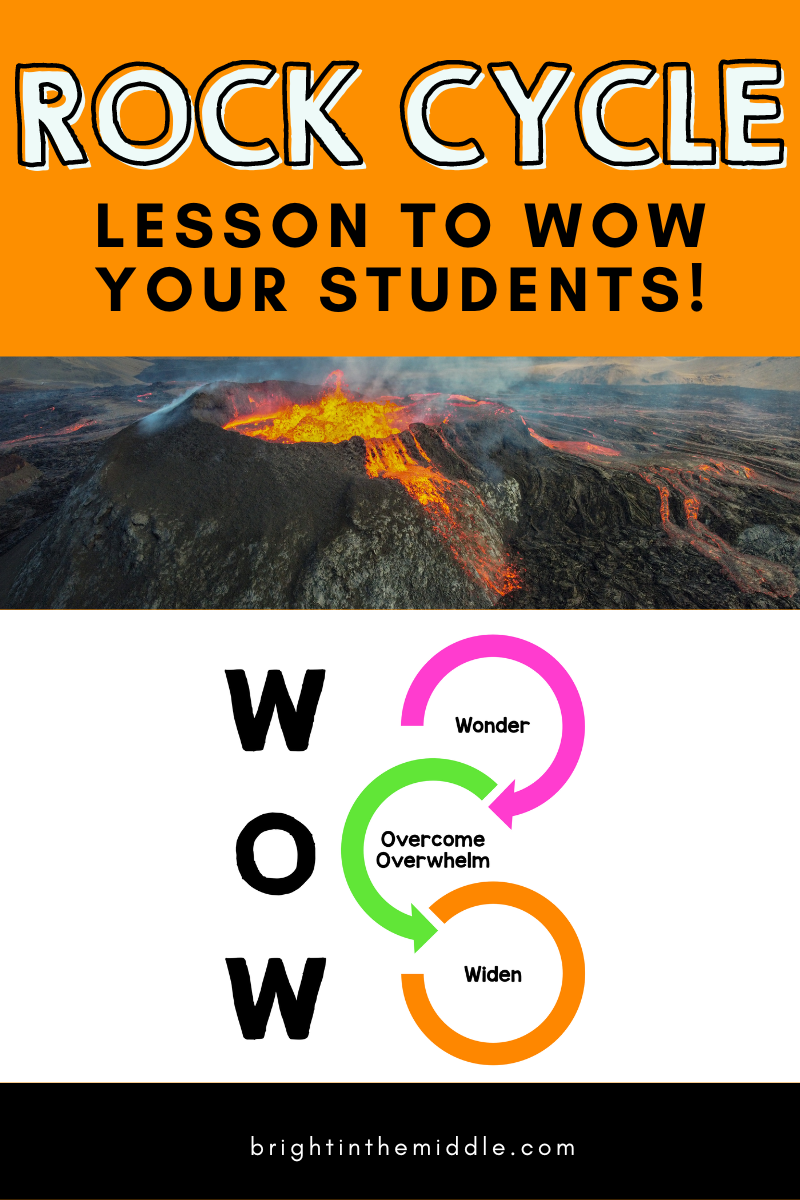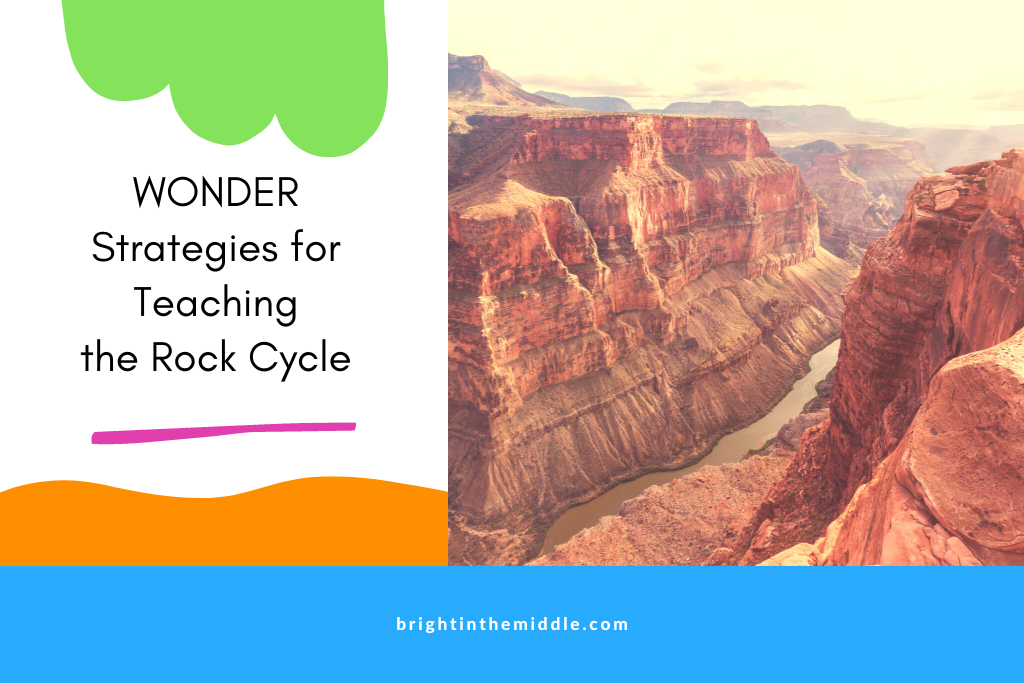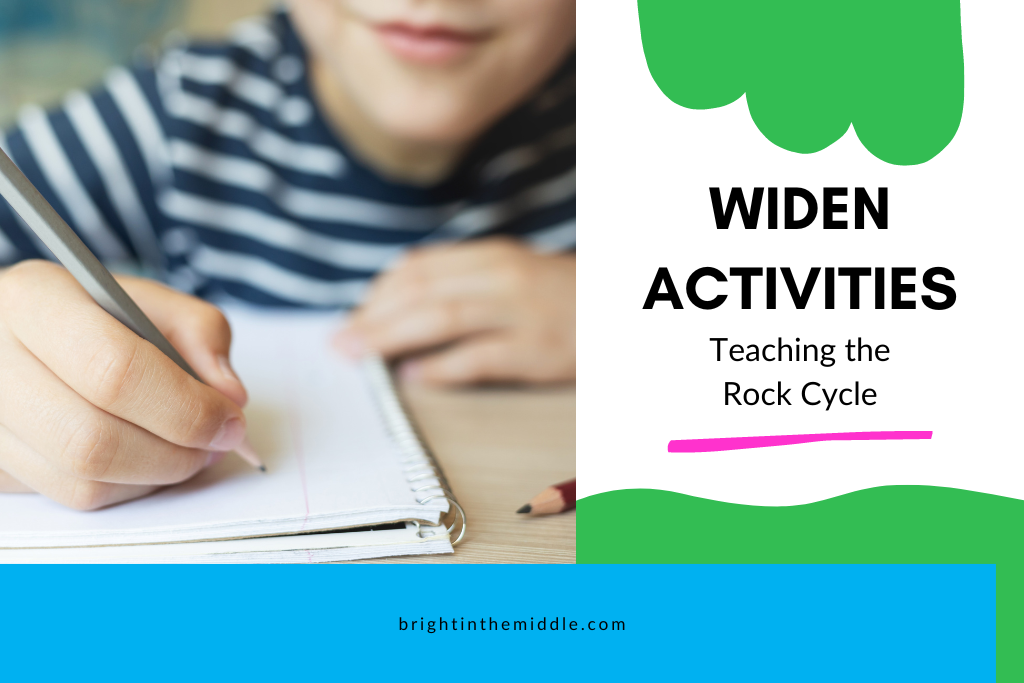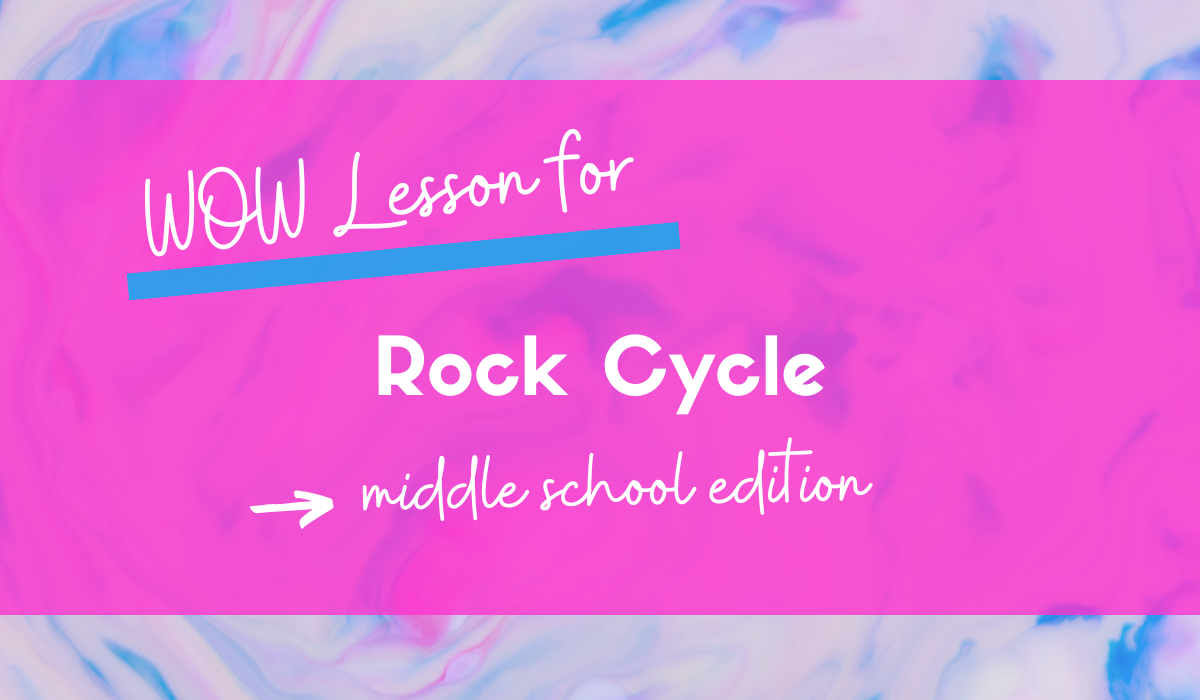Teaching the steps in the rock cycle? Story time. I honestly do not remember much about learning about rocks and the rock cycle until I got to college. Back in middle school, I promise, we mainly read textbooks and answered questions at the end. I think there is a time and place for reading and answering questions, don’t get me wrong, but learning science is SO much more than that!
Well, when I was in college, I did learn a lot about rocks and the rock cycle in Geology class. Although the teacher wasn’t the greatest at delivering information, we did observe A LOT of rocks, and luckily I had my 3 best friends in that class, so of course, that helped to make it very memorable!
So, I say all this to say, delivery of this topic is crucial. I love science, and I had a hard time grasping on to this, because it can be kind of dry; however, there are ways that you can bring the WOW factor to your middle school classroom so that this lesson will be fun and stick in your students’ long-term memory.
In this post, I will first share some introductory activities that you can do with your students to get hyped up about learning the steps of the rock cycle. Then, I will share an interactive lesson with you that focuses on reducing cognitive load and student engagement. Finally, I will share some ideas with you on how to help your students widen their knowledge on this topic. This is the Rock Cycle WOW Factor lesson!

What’s a fun way to introduce the rock cycle?
Before you begin your lesson, it’s important to get your students internally motivated to learn about rocks. They see rocks all of the time, so it may not be so intriguing. Your job is to make it the most exciting thing in the world!! Here are a few examples of ideas that you can try.
Observe Rocks and Minerals
So, your students see rocks all of the time, but they don’t see ALL of the neat rocks and minerals. There are a ton of kits out there that you can ask your school for, or they may already have a collection!
Before even teaching the lesson, have your students observe rocks and minerals. You can give them some guiding questions such as:
- Do you notice any difference between rocks and minerals?
- What features do you notice about each rock and mineral?
- How can you tell these rocks and minerals apart?
- Are there any distinguishing features?
- How do you think each one was created?
Some things may stand out to students such as the lightness of pumice, the smell of sulfur, the smoothness of obsidian, the shininess of pyrite, and more!
What is rock and rock cycle? Once you get to the point where your students are asking a million questions, you have them right where you want them to be!

Grand Canyon Tour
Another thing to get them hyped about learning about rocks is to take a Grand Canyon Tour on Google Earth!
The Grand Canyon is mostly made of sedimentary rock, and it’s fascinating to think of how it was created!
This can be an open-ended lesson where students just explore the Grand Canyon by going through the different map points that are provided. They can use the arrows in the lower right-hand corner. In addition, they can move around on the screen to look around even further.
Two things that your students can focus on during the tour:
- What do you notice about the rocks?
- How was the Grand Canyon formed?
They can use the internet as a resource to try to find some of these answers for themselves.
Invite a Geologist
What better way to get excited about rocks and the rock cycle than to talk to someone who absolutely loves the work with rocks! They love it so much that they make it a career!
I think that exposing middle school students to as many STEM careers as possible is crucial. In middle school, they are really starting to explore their interests, and having many options is nice! A lot of students may not know that being a geologist is a career choice!
Where can you find a geologist? Depending on where you live, you might have a local college where you can ask a professor if they would be interested to speak. You may also live near a local museum where a geologist may be hired. They can work at a lot of different places. Just Google “Geologists near me” and see what comes up!
If there is no local geologists, you can check out Skype a Scientist. This is a great way to chat with a scientist online!
A volcanist is also another great guest speaker to have before learning this topic! Magma and lava play a HUGE role in the rock cycle.
Rock Cycle Lesson
What is the purpose of the rock cycle? Is the rock cycle really a cycle? What are the steps in the rock cycle? Time to answer some questions!
At this point, hopefully your students are hyped up and are beginning to WONDER and have more questions about rocks and the rock cycle, so now it’s time to dive deeper into the lesson. There is a lot of vocabulary that is associated with this topic, so I think that an interactive lesson is the perfect approach.
Interactive lessons focus on the 7 steps to help students retain information and keep it in their long-term memory. One of the major characteristics of these lessons is the chunking of information and embedded questions to help students process information a bit at a time.
The reason that this is important is because, if students are given too much information at one time, that overloads their working memory. Students will not learn anything at all.
This particular Rock Cycle Lesson covers a lot of ground, but makes it fun and exciting for the students to go through. It covers what a rock is, how rocks are categorized, the types of rocks, and how they are created, changed, and broken down in the rock cycle. They’ll look at the rock cycle transition. This lesson is jam-packed with vocabulary, but there are many opportunities for students to process this vocabulary and to really understand how the rock cycle works.
The embedded activities that are included are typing in the text box, an anticipation guide, drag-and-drop activities, exploring outside resources, and so much more!
You can also find this on TPT.
If you are interested in diving deeper into minerals before teaching about rocks, there is an interactive lesson for that as well!
Widen Activities to Describe the Steps in the Rock Cycle
By now, your students have learned a lot and are either ready to learn more, show off their new knowledge, or both! This is where a WIDEN activity would be wonderful! There are so many things that you can do to widen student knowledge on the process in the rock cycle. I’ll share 3 ideas with you today!
Candy Rock Cycle Model
This is a great way to model the rock cycle.
In this lab, students will use candy to model and explain the rock cycle. They explore weathering, erosion, deposition, sedimentation, lithification, metamorphism, crystallization, and more.
You’ll need:
- candy (Airheads, Starbursts, etc. work well)
- aluminum foil
- a heat source (such as a hot plate, candle, hot water, etc.)
- plastic knifes (optional – for weathering)
It’s a lot of fun! If you are looking for a pre-made presentation and student worksheet, you can check this activity out inside the Bright in the Middle Membership!
Rock Cycle Story
One of the requirements in many states is for students to create a model to represent the rock cycle. You can choose to do something like the Starburst model, or your students can choose to create a model using a story! They can write the story in different perspectives.
There are so many options that your students can choose from:
They can start as an igneous rock, a metamorphic rock, or a sedimentary rock. They can begin as magma or sediment as well.
Their task will be to write a story in the perspective of one of the things listed above and share their journey through the rock cycle.
A bonus would be to write 2 different stories. They may see the steps of the rock cycle in order; however, the rock cycle isn’t always a continuous cycle It can go many different directions!
There are different rock cycle story examples online to get inspiration.

Develop Your Own Model
Pressed for time, but still want to meet the standards? You can check out this activity from TeachEngineering! In this activity, students are tasked to develop their own rock cycle by drawing.
They must meet five different criteria in order to be successful!
One thing that you could do is to have students look at different models of the rock cycle and make it their own based on the information that they’ve learned. There are a lot of different ones out there, and this is a great opportunity for students to make connections.
What will you add to your steps in the rock cycle lesson?
Help your students master science content!



[…] The Rock Cycle […]